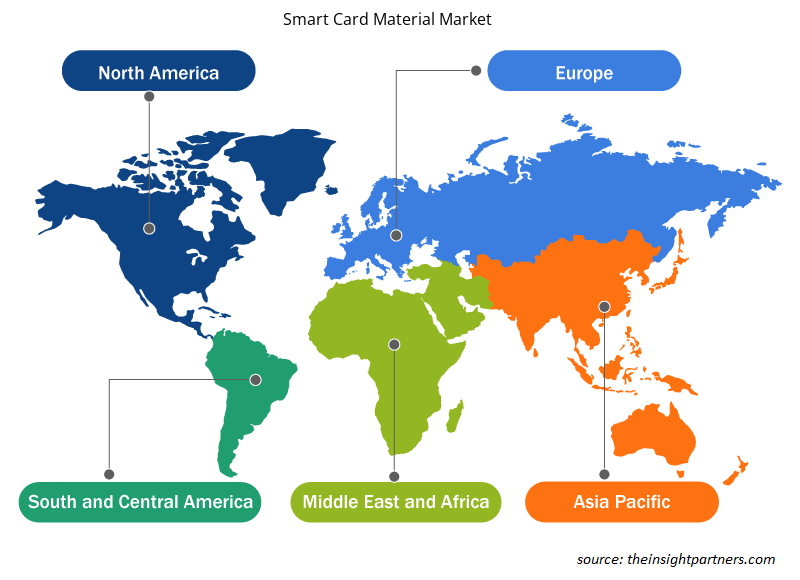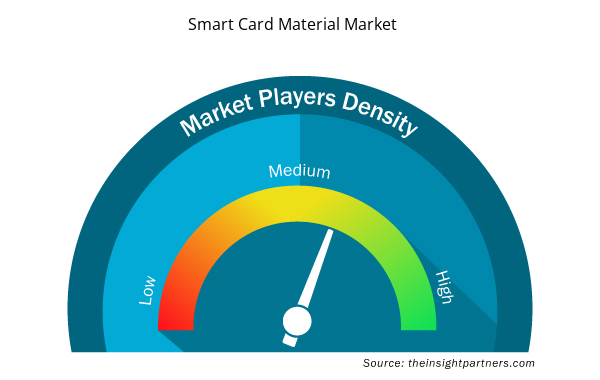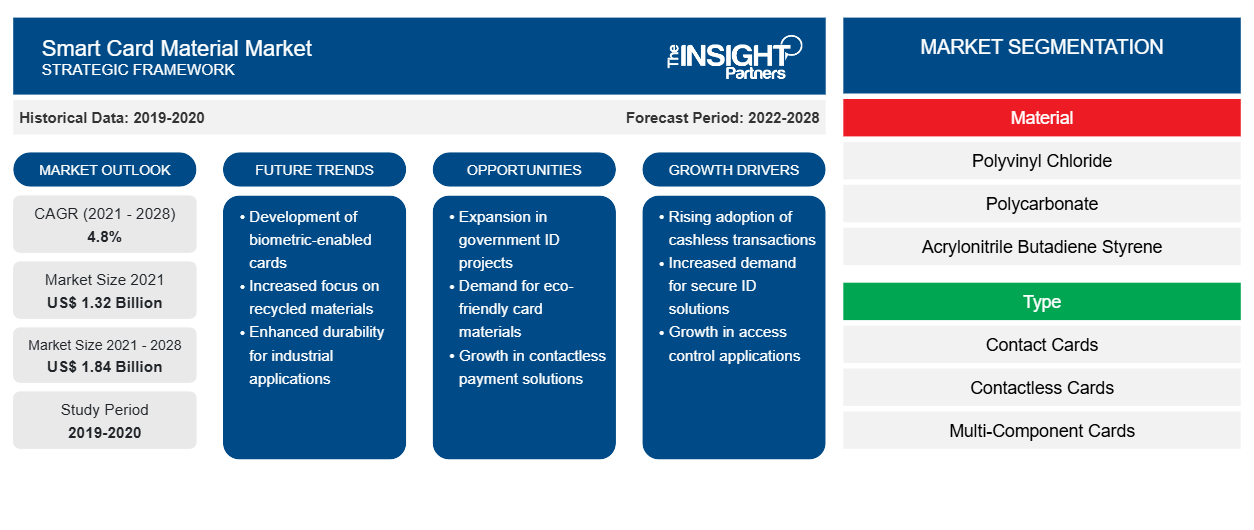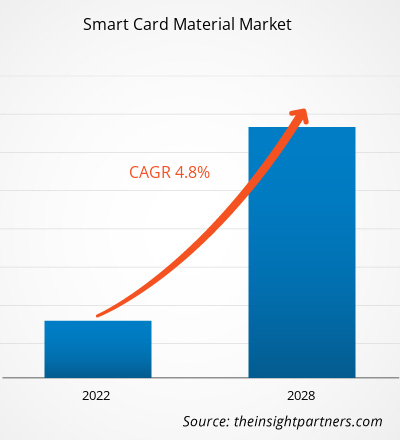Le marché des matériaux pour cartes à puce devrait atteindre 1 837,78 millions USD d'ici 2028, contre 1 324,57 millions USD en 2021 ; il devrait croître à un TCAC de 4,8 % de 2021 à 2028.
Une carte à puce, un type de carte à puce, est une carte en plastique qui contient une puce informatique intégrée, de type mémoire ou microprocesseur, qui stocke et traite des données. Ces données sont généralement associées à une valeur ou à des informations, ou aux deux, qui sont stockées et traitées dans la puce. Les matériaux des cartes à puce font référence aux matériaux chimiques utilisés dans la fabrication de ces cartes. Ces matériaux permettent l'intégration et l'impression d'informations sur celles-ci.
En 2020, la région Asie-Pacifique détenait la plus grande part du marché mondial des matériaux pour cartes à puce . La demande de matériaux pour cartes à puce dans cette région augmente en raison de l'utilisation croissante des cartes à puce dans le secteur des télécommunications. En outre, la tendance croissante à la mondialisation et la prolifération du secteur bancaire, des services financiers et des assurances (BFSI) sont des facteurs clés favorisant la croissance du marché des matériaux pour cartes à puce dans la région.
Personnalisez ce rapport en fonction de vos besoins
Vous bénéficierez d'une personnalisation gratuite de n'importe quel rapport, y compris de certaines parties de ce rapport, d'une analyse au niveau des pays, d'un pack de données Excel, ainsi que d'offres et de remises exceptionnelles pour les start-ups et les universités.
- Obtenez les principales tendances clés du marché de ce rapport.Cet échantillon GRATUIT comprendra une analyse de données, allant des tendances du marché aux estimations et prévisions.
Impact de la pandémie de COVID-19 sur le marché des matériaux pour cartes à puce
La pandémie de COVID-19 en cours a radicalement modifié le statut du secteur des produits chimiques et des matériaux et a eu un impact sur la croissance du marché des matériaux pour cartes à puce. La baisse significative des performances de plusieurs secteurs industriels a eu un impact sur la demande de matériaux pour cartes à puce. L'impact de la pandémie varie selon les différents segments d'application. Une augmentation du trafic de données et des services vocaux a profité à de nombreux acteurs des télécommunications, notamment aux opérateurs de centres de données à large bande et mobiles. Cependant, les mesures de confinement imposées par les gouvernements ont perturbé les chaînes d'approvisionnement en matières premières telles que le PVS, l'ABS et le PETG nécessaires à la fabrication de cartes à puce. La propagation de la maladie a eu un impact négatif sur les opérations des secteurs public et BFSI. Cependant, alors que les économies prévoient de relancer leurs opérations, la demande de matériaux pour cartes à puce devrait augmenter à l'échelle mondiale dans les années à venir.
Informations sur le marché
Croissance significative dans les secteurs des télécommunications et de la santé
Les cartes à puce sont largement utilisées dans le secteur des télécommunications. Les cartes à puce les plus utilisées dans ce secteur sont les cartes SIM (Subscriber Identity Module) ou les cartes à circuit intégré universelles (UICC). Ces cartes à puce sont principalement fabriquées à partir de matériaux en chlorure de polyvinyle (PVC) et en acrylonitrile butadiène styrène (ABS). La technologie des cartes à puce utilisée dans les applications de ce secteur a connu des progrès continus au cours des dernières années, ce qui a stimulé la consommation de ces cartes. En outre, les organisations de soins de santé du monde entier mettent en œuvre des cartes de santé à puce dotées d'un large éventail de fonctionnalités et d'applications.
Aperçu régional du marché des matériaux pour cartes à puce
Les tendances et facteurs régionaux influençant le marché des matériaux pour cartes à puce tout au long de la période de prévision ont été expliqués en détail par les analystes d'Insight Partners. Cette section traite également des segments et de la géographie du marché des matériaux pour cartes à puce en Amérique du Nord, en Europe, en Asie-Pacifique, au Moyen-Orient et en Afrique, ainsi qu'en Amérique du Sud et en Amérique centrale.

- Obtenez les données régionales spécifiques au marché des matériaux pour cartes à puce
Portée du rapport sur le marché des matériaux pour cartes à puce
| Attribut de rapport | Détails |
|---|---|
| Taille du marché en 2021 | 1,32 milliard de dollars américains |
| Taille du marché d'ici 2028 | 1,84 milliard de dollars américains |
| Taux de croissance annuel moyen mondial (2021-2028) | 4,8% |
| Données historiques | 2019-2020 |
| Période de prévision | 2022-2028 |
| Segments couverts | Par matériau
|
| Régions et pays couverts | Amérique du Nord
|
| Leaders du marché et profils d'entreprises clés |
|
Densité des acteurs du marché des matériaux pour cartes à puce : comprendre son impact sur la dynamique commerciale
Le marché des matériaux pour cartes à puce connaît une croissance rapide, tirée par la demande croissante des utilisateurs finaux en raison de facteurs tels que l'évolution des préférences des consommateurs, les avancées technologiques et une plus grande sensibilisation aux avantages du produit. À mesure que la demande augmente, les entreprises élargissent leurs offres, innovent pour répondre aux besoins des consommateurs et capitalisent sur les tendances émergentes, ce qui alimente davantage la croissance du marché.
La densité des acteurs du marché fait référence à la répartition des entreprises ou des sociétés opérant sur un marché ou un secteur particulier. Elle indique le nombre de concurrents (acteurs du marché) présents sur un marché donné par rapport à sa taille ou à sa valeur marchande totale.
Les principales entreprises opérant sur le marché des matériaux pour cartes à puce sont :
- Société chimique Eastman
- Société à responsabilité limitée PetroChina
- Solvay SA
- KEM UN
- SABIC
Avis de non-responsabilité : les sociétés répertoriées ci-dessus ne sont pas classées dans un ordre particulier.

- Obtenez un aperçu des principaux acteurs du marché des matériaux pour cartes à puce
Informations sur les applications
En fonction des applications, le marché des matériaux pour cartes à puce est segmenté en BFSI, gouvernement, télécommunications, vente au détail, soins de santé, hôtellerie et autres. Le segment des télécommunications détenait la plus grande part du marché des matériaux pour cartes à puce en 2020. Les cartes à puce sont utilisées comme cartes téléphoniques prépayées (cartes mémoire à valeur stockée) et comme cartes SIM à base de cartes à puce à microprocesseur ou UICC dans les téléphones mobiles. Les produits de cartes à puce les plus vendus dans ce secteur sont les cartes SIM et UICC, en termes de volume et de valeur.
Quelques-uns des acteurs opérant sur le marché mondial des matériaux pour cartes à puce incluent Eastman Chemical Company, PetroChina Company Limited, Solvay SA, KEM ONE, SABIC, 3A Composites GmbH, Teijin Limited, LG Chem, BASF SE et Westlake Chemical Corporation.
Rapports en vedette
- Tendances industrielles progressistes sur le marché des matériaux pour cartes à puce pour aider les acteurs à développer des stratégies efficaces à long terme
- Stratégies de croissance des entreprises adoptées par les entreprises opérant sur les marchés développés et en développement
- Analyse quantitative du marché des matériaux pour cartes à puce de 2019 à 2028
- Estimation de la demande mondiale en matériaux pour cartes à puce
- Analyse des cinq forces de Porter pour illustrer l'efficacité des acheteurs et des fournisseurs opérant dans l'industrie
- Développements récents pour comprendre le scénario concurrentiel du marché
- Tendances et perspectives du marché ainsi que facteurs qui stimulent et freinent la croissance du marché des matériaux pour cartes à puce
- Aide au processus de prise de décision en mettant en évidence les stratégies de marché qui sous-tendent l'intérêt commercial, conduisant à la croissance du marché des matériaux pour cartes à puce
- La taille du marché des matériaux pour cartes à puce à différents niveaux
- Aperçu détaillé et segmentation du marché, ainsi que de la dynamique de l'industrie des matériaux pour cartes à puce
- Taille du marché des matériaux pour cartes à puce dans diverses régions avec des opportunités de croissance prometteuses
Marché des matériaux pour cartes à puce
Par matériau
- Chlorure de polyvinyle (PVC)
- Polycarbonate (PC)
- Acrylonitrile butadiène styrène (ABS)
- Polyéthylène téréphtalate-glycol (PETG)
- Autres
Par type
- Cartes de contact
- Cartes sans contact
- Cartes multi-composants
Par application
- BFSI
- Gouvernement
- Télécommunication
- Vente au détail
- Soins de santé
- Hospitalité
- Autres
Profils d'entreprise
- Société chimique Eastman
- Société à responsabilité limitée PetroChina
- Solvay SA
- KEM UN
- SABIC
- 3A Composites GmbH
- Teijin Limitée
- Chimie LG
- BASF SE
- Société chimique Westlake
- Analyse historique (2 ans), année de base, prévision (7 ans) avec TCAC
- Analyse PEST et SWO
- Taille du marché Valeur / Volume - Mondial, Régional, Pays
- Industrie et paysage concurrentiel
- Ensemble de données Excel



Report Coverage
Revenue forecast, Company Analysis, Industry landscape, Growth factors, and Trends

Segment Covered
This text is related
to segments covered.

Regional Scope
North America, Europe, Asia Pacific, Middle East & Africa, South & Central America

Country Scope
This text is related
to country scope.
Questions fréquemment posées
The contactless cards segment is the fastest growing segment in the global smart card material market during the forecasted period. Contactless cards are the smart cards with contactless credentials and have a size like credit cards or debit cards. The market for the contactless cards segment is growing due to its various benefits.
The telecommunication segment held the largest share of the market in 2021. In the telecommunication industry, smart cards are used in two primary applications. Firstly, it is used as prepaid (stored value memory cards) telephone cards and as the microprocessor smart card-based subscriber identity module (SIM) or universal integrated circuit card (UICC) in mobile phones.
The contact cards segment held the largest share of the market in 2021. Contact cards are the smart cards that have a size like conventional debit and credit card. Contact smart card contains a single, embedded, and integrated circuit chip that consists of either memory or memory plus microprocessor.
The polyvinyl chloride segment held the largest share of the global smart card material market in 2021. Polyvinyl chloride is the most common and strong plastic material used for card manufacturing. The material is used for contact and contactless cards.
The major players operating in the global smart card material market are Eastman Chemical Company; PetroChina Company Limited; Solvay S.A.; KEM ONE; SABIC; 3A Composites GmbH; Teijin Limited; LG Chem; BASF SE; and Westlake Chemical Corporation; among others.
In 2021, Asia Pacific held the largest share of the global smart card material market. The major factor driving the smart card materials market in the Asia Pacific region is the increasing use of smart cards in various applications such as government, transportation, retail, and education sectors.
Trends and growth analysis reports related to Chemicals and Materials : READ MORE..
The List of Companies - Smart Card Materials Market
- Eastman Chemical Company
- PetroChina Company Limited
- Solvay S.A.
- KEM ONE
- SABIC
- 3A Composites GmbH
- Teijin Limited
- LG Chem
- BASF SE
- Westlake Chemical Corporation
The Insight Partners performs research in 4 major stages: Data Collection & Secondary Research, Primary Research, Data Analysis and Data Triangulation & Final Review.
- Data Collection and Secondary Research:
As a market research and consulting firm operating from a decade, we have published and advised several client across the globe. First step for any study will start with an assessment of currently available data and insights from existing reports. Further, historical and current market information is collected from Investor Presentations, Annual Reports, SEC Filings, etc., and other information related to company’s performance and market positioning are gathered from Paid Databases (Factiva, Hoovers, and Reuters) and various other publications available in public domain.
Several associations trade associates, technical forums, institutes, societies and organization are accessed to gain technical as well as market related insights through their publications such as research papers, blogs and press releases related to the studies are referred to get cues about the market. Further, white papers, journals, magazines, and other news articles published in last 3 years are scrutinized and analyzed to understand the current market trends.
- Primary Research:
The primarily interview analysis comprise of data obtained from industry participants interview and answers to survey questions gathered by in-house primary team.
For primary research, interviews are conducted with industry experts/CEOs/Marketing Managers/VPs/Subject Matter Experts from both demand and supply side to get a 360-degree view of the market. The primary team conducts several interviews based on the complexity of the markets to understand the various market trends and dynamics which makes research more credible and precise.
A typical research interview fulfils the following functions:
- Provides first-hand information on the market size, market trends, growth trends, competitive landscape, and outlook
- Validates and strengthens in-house secondary research findings
- Develops the analysis team’s expertise and market understanding
Primary research involves email interactions and telephone interviews for each market, category, segment, and sub-segment across geographies. The participants who typically take part in such a process include, but are not limited to:
- Industry participants: VPs, business development managers, market intelligence managers and national sales managers
- Outside experts: Valuation experts, research analysts and key opinion leaders specializing in the electronics and semiconductor industry.
Below is the breakup of our primary respondents by company, designation, and region:

Once we receive the confirmation from primary research sources or primary respondents, we finalize the base year market estimation and forecast the data as per the macroeconomic and microeconomic factors assessed during data collection.
- Data Analysis:
Once data is validated through both secondary as well as primary respondents, we finalize the market estimations by hypothesis formulation and factor analysis at regional and country level.
- Macro-Economic Factor Analysis:
We analyse macroeconomic indicators such the gross domestic product (GDP), increase in the demand for goods and services across industries, technological advancement, regional economic growth, governmental policies, the influence of COVID-19, PEST analysis, and other aspects. This analysis aids in setting benchmarks for various nations/regions and approximating market splits. Additionally, the general trend of the aforementioned components aid in determining the market's development possibilities.
- Country Level Data:
Various factors that are especially aligned to the country are taken into account to determine the market size for a certain area and country, including the presence of vendors, such as headquarters and offices, the country's GDP, demand patterns, and industry growth. To comprehend the market dynamics for the nation, a number of growth variables, inhibitors, application areas, and current market trends are researched. The aforementioned elements aid in determining the country's overall market's growth potential.
- Company Profile:
The “Table of Contents” is formulated by listing and analyzing more than 25 - 30 companies operating in the market ecosystem across geographies. However, we profile only 10 companies as a standard practice in our syndicate reports. These 10 companies comprise leading, emerging, and regional players. Nonetheless, our analysis is not restricted to the 10 listed companies, we also analyze other companies present in the market to develop a holistic view and understand the prevailing trends. The “Company Profiles” section in the report covers key facts, business description, products & services, financial information, SWOT analysis, and key developments. The financial information presented is extracted from the annual reports and official documents of the publicly listed companies. Upon collecting the information for the sections of respective companies, we verify them via various primary sources and then compile the data in respective company profiles. The company level information helps us in deriving the base number as well as in forecasting the market size.
- Developing Base Number:
Aggregation of sales statistics (2020-2022) and macro-economic factor, and other secondary and primary research insights are utilized to arrive at base number and related market shares for 2022. The data gaps are identified in this step and relevant market data is analyzed, collected from paid primary interviews or databases. On finalizing the base year market size, forecasts are developed on the basis of macro-economic, industry and market growth factors and company level analysis.
- Data Triangulation and Final Review:
The market findings and base year market size calculations are validated from supply as well as demand side. Demand side validations are based on macro-economic factor analysis and benchmarks for respective regions and countries. In case of supply side validations, revenues of major companies are estimated (in case not available) based on industry benchmark, approximate number of employees, product portfolio, and primary interviews revenues are gathered. Further revenue from target product/service segment is assessed to avoid overshooting of market statistics. In case of heavy deviations between supply and demand side values, all thes steps are repeated to achieve synchronization.
We follow an iterative model, wherein we share our research findings with Subject Matter Experts (SME’s) and Key Opinion Leaders (KOLs) until consensus view of the market is not formulated – this model negates any drastic deviation in the opinions of experts. Only validated and universally acceptable research findings are quoted in our reports.
We have important check points that we use to validate our research findings – which we call – data triangulation, where we validate the information, we generate from secondary sources with primary interviews and then we re-validate with our internal data bases and Subject matter experts. This comprehensive model enables us to deliver high quality, reliable data in shortest possible time.


 Obtenez un échantillon gratuit pour ce rapport
Obtenez un échantillon gratuit pour ce rapport